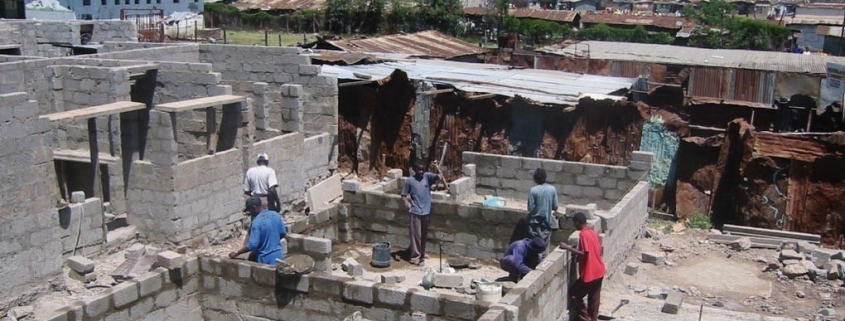The Impacts of Self-Help Housing Implementation to Households Livelihood Assets
Annabel Noor Asyah S.T., M.Sc.
Generally house known as a shelter, place that provide protection from danger and weather. However, the meaning of housing is actually more than that. It is not only about a place with specific structures but also about the activities that the households do to live and improve their life that related to the livelihoods concept. There are several housing theories and concepts that make us have better understanding about what actually housing is and alternative housing provision scheme that perceived effective especially for people who live in urban poverty. One of them is self-help concept, a popular idea about housing by John F.C Turner, an English Architect who had experiences in housing development in Latin America. In this essay the argument about the connection between self-help theory with livelihood theory will be developed.
Like a chapter of his book, Turner introduced the idea about “housing as a verb” which described housing as a process that human life depends on, not only as a product. Such activities like nurturing the children, taking care of ourselves, and preparing the foods are processes that essential to households life. According to Turner, based on the strong engagement between housing and households activities, decision making power about housing have to be decided by the house users themselves because they know better about what they need or users as the principal actors. The main idea of self-help is the house users have the freedom to build, to use and manage the house by their own way (Turner, 1972). The characteristics of self-help concept are: It is a house-users design and management process; Emphasizes the crucial term of “who-decides” which leads to autonomy concept with the house-users as the decision makers (Harris,2003); Limits the government intervention (Jenkins, 2007). Although the house-users have bigger portion of role to provide houses, they still need government support to provide things that they can not provide alone, such as basic infrastructures like the road and sewage. Government also have to make laws about limitation of what people can do also have to provide and protect access to element of housing process such as land, materials, tools etc. (Nientied, 1988).
To have a better understanding about the role of housing, we also need to pay attention to the livelihoods theory. Livelihoods known as combination of activities, assets, and capabilities of the households to assure that they can survive, maintain and improve their welfare (Rakodi, 2002). One of the main factors that influences the livelihood is asset. There several kind of assets such as physical, natural, human, social and financial asset. All of them are influencing each other and affect the ability of household to managing their living. Physical asset identified as the availability of basic infrastructures such as housing, tools to access water etc which important for people to make their living. Housing that categorized as physical assets play an important role that influencing other assets such as human and financial assets.
Human asset which known as the availability of labour resources within households divided into quantitative and qualitative dimensions. Quantitative dimension is more about the number of people. Meanwhile qualitative is about the education levels, skills, and health status of each person in a household (Rakodi, 2002). Housing influences the human asset in a significant way. For example in the case of forced eviction in Abuja, Nigeria, people who affected the forced eviction gave their testimonials and expressed their feeling after the forced eviction happened. They lost their houses as the asset. They feel shocked and depressed because they did not have house anymore and have to live in the street. One of the interviewees known have to sleep in the street for days, and got sick physically and mentally. And after several days tried to survive, he died. That is a concrete example about how house as physical asset influences human asset which is household’s health both physically and mentally.
Financial asset identified as resources related to the availability of money which make the households have financial options such as credit, pensions, savings, and remittances (Rakodi, 2002). Financial asset also influenced by the physical asset. For example for people who work in home or home-based workers. According to Chen & Sinha (2016, p. 346), “For home-based workers, whose home is also their workplace, housing is an essential productive asset”. For example in case of Ahmedabad, Pakistan, where a group of waste plastic recyclers who work at home have to be relocated to a new site because their existing place should be functioning as floodplain to control flooding in the future. They would lost their work which resulted on the inability to pay the bills and have to reducing the expenditures. One group that had been relocated to the new site said that even the government gave them a new house, they still can not find a new job and it was hard for them to survive in the new site. They start to borrowing money from each other. That case shows the real example about how house become a place for generating income which related to financial asset.
After all, self-help approach and livelihood theory are linked in a complementary way. The application of self-help enriches the livelihood assets for the people. By designing and managing their houses, the users will have skills like the ability to design, construct, build and manage their own house based on their own needs that related to their human asset. They also know their needs about the size, the number of rooms so their house will be efficient for them to live. This condition might not be found if people just directly buy the houses from public or private company. Related to the financial asset, people will build their houses based on their own financial condition. They will have the opportunity to manage their own money to build without sacrificing their other needs. Usually people will have tendency to build the house near the workplace, so the self-help approach will help them increase their income. To the social asset, self-help approach also will give the beneficial influences such as, the sense of belonging to the community surrounding the house because they build it by themselves and often get help from the neighbours. People also have tendency to build their house near their relatives, so it will strengthen the relations due to the proximity to each other. Related to nature asset, people who use the self-help approach have the opportunity to build their house near the natural resources so they can improve their life with easy access to natural resources such as water and land. This natural resources also can help people bettering their financial asset by using them as opportunity to work.
The explanation about conectivity between self-help housing concept and livelihood assets is a picture about how housing system works in Indonesia today. According to Johan Silas in his book “Perumahan Dalam Jejak Paradoks” (2016), housing system in Indonesia preceived as a plane that devided into 2 classes, business and economy class. 70% of the plane passengers are from economy class, yet they are the ones who make the plane operated, not the rest 30%. This analogy is perfectly describes the housing system in Indonesia where almost 70% of houses in Indonesia are informal, and the rest 30% are provided by formal system. This shows how self-help housing is the first option for Indonesian to build their houses. People who can not afford housing from formal sector, eventually would build their own houses by adjusting their assets such financial asset, physical asset, natural asset, human asset and social asset.
In conclusion, self-help approach which is limiting government intervention and let the house-user build and manage their own houses is complementarily linked to the livelihood theory which highlight the 5 kind of assets. Self-help approach strengthen people’s asset and give them opportunity to manage their life based on what they need. However, some kind of the government’s roles should be considered such as provide basic services and giving land protection to support what the people can not provide by themselves.
References
- Chen, M.A., & Sinha, S. (2016). Home-based workers and citiea. Environment and Urbanization, 28(2), 343-358.
- Harris, R. (2003). A double irony: the originality and influence of John. F.C. Turner. Habitat International, 27, 245-269.
- Jenkins, P., Smith, H ad Wang, Y. (eds). (2007). Planning and Housing in Rapidly Urbanising World. Routledge, London and New York. (Chapter 7: Housing in the period 1960-90, pp.153-177).
- Nientied, P. And van der Linden, J. (1988). Approaches to low income housing in the Third World. Chapter 9 (138-156) in Gugler, J. (ed.). The Urbanisation of the Third World. Oxford University Press, New York.
- Rakodi, C. (2002). A livelihoods approach-conceptual issues and definitions. Urban livelihoods: A people-centred approach to reducing poverty, 3-22.
- Turner, J. (1972). Chapter 7: Housing as a Verb (pp148-175) in Turner,J. & Fichter, R., (eds) 1972. Freedom to Build: Dweller Control of the Housing Process. Macmillan, New York.
- Silas, J. (2016). Perumahan Dalam Jejak Paradoks. Laboratorium Perumahan dan Permukiman Institut Teknologi Sepuluh Nopember, Surabaya.

